The Laser Cinema TV isn't really a TV at all, but a compact short-throw projector capable of a 100-inch Full HD (1080p) image, and equipped with Hisense's "Vidaa" smart platform.
During its press conference Monday, Hisense boldly claimed that projection technology was the future of the consumer display market, and that "cumbersome" LCDs were on the way out. That remains to be seen, but the Laser Cinema TV is still a unique and allegedly affordable home theater solution—and it really doesn't look half bad, either.
Plus, lasers are cool.
The Looks
A short-throw projector by another name...
The Laser Cinema TV is actually a compact, sleekly designed short-throw projector that sits upon a given surface and projects its image onto the wall behind.
I didn't get to go "hands-on" with the device, unfortunately—they yelled at me when I got too close—but I did get a good look at it from a few different angles. The hardware looks futuristic and sturdy... for a projector, anyway.
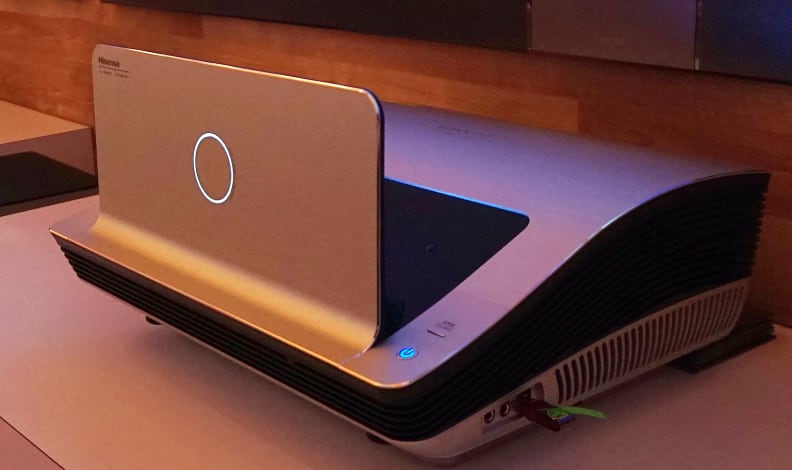
The contoured Laser Cinema TV (a short-throw projector) 3.96 inches from a wall. The raised, flat area casts the projected image onto a surface.
Hisense says it will sell the Laser Cinema TV as a standalone product, or package it with wireless speakers and a 100-inch fresnel projection screen. They're calling it a "Home Theater in a Parcel."
I didn't get to play with any buttons or menu software, or even see the projector's connectivity options, but Hisense claims it'll offer up the same AV port spread as one of the company's Vidaa-branded HDTVs: a few HDMI inputs, component, composite, RF in, and a couple of analog/digital audio output ports.
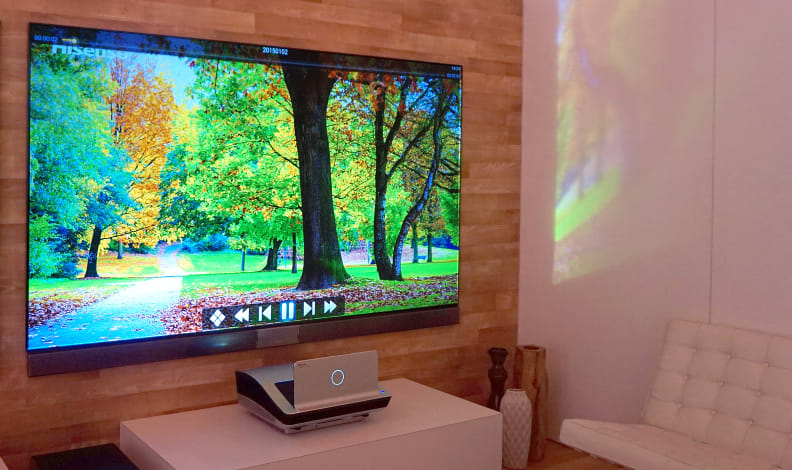
The Laser Cinema TV will include optional accessories, like a 100-inch fresnel projection screen and wireless speakers.
Hisense claimed the laser projector approach to display technology results in a 40% decrease in energy draw compared to a similarly-sized LCD TV. They also touted the projector's ease-of-use, describing it as a plug-and-play solution that users could set up in "less than 10 minutes."
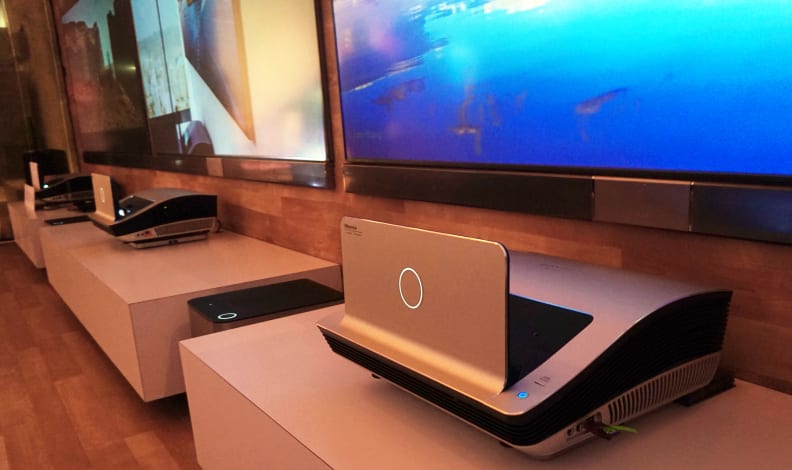
Projectors on parade: The Laser Cinema TV works with an optional fresnel screen or casts its image directly onto the wall, and only weighs 40 pounds.
The product also supports Hisense's "Vidaa" smart platform and has built-in WiFi capability, allowing users to stream content from popular providers like Netflix and Amazon Instant Video. It's also a much easier way to access your personal media, like home movies or photo albums, stored on a network drive.
The Picture
Fuzzy up close, but perfect for Super Bowl Sunday.
So you buy your Laser Cinema projector, pop it onto the TV stand in the basement, and plug your set-top-box into one of the HDMI inputs. That part sounds simple enough, and simple setup is always great, but what really matters is the picture.
If you're a stickler for high resolution, your reaction to the Laser Cinema TV's spec list was probably exactly the same as mine: "It's a 100-inch screen and 1080p, not 4K? That's going to look all fuzzy and blurry, man." And it does—up close. At this size, however, you'd want to be at least 10 feet away.
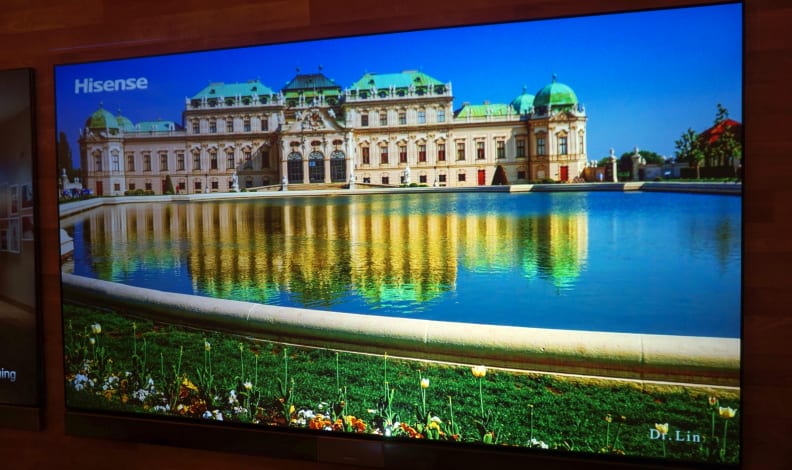
Up close, the Laser Cinema TV looks a little "soft," but its image holds up nicely in terms of color and contrast.
In my opinion, the screen never looks quite as sharp as a flat-panel TV, but it does have that cinematic, projected look that some people really enjoy. What truly impressed me, though, was how bright the image was; Hisense claims the lamp throws 2,500 lumens, or about 27,000 nits, which is a ton of light. Even with the lights on, the Laser Cinema TV's projected image was plenty bright, with ample contrast.
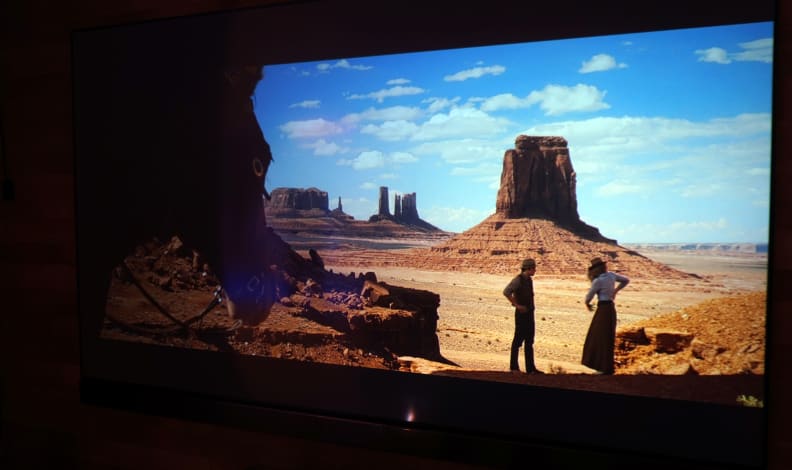
This scene from "A Million Ways to Die in the West" had plenty of contrast, and good juxtaposition of bright and dark elements on screen.
As for overall image quality, things are looking pretty promising, but we have some reservations, too. The resolution is low for a 100-inch screen, yes, and the refresh rate is only 60Hz, which could harm adoption by super-serious gamers.
On the other hand, reps from Hisense claimed the TV could hit 84% of the NTSC color standard, which is believable based on the vivacity of some of the content on parade. The projector's short-throw orientation also makes for better light uniformity from corner-to-corner compared to edge-lit LED TVs.
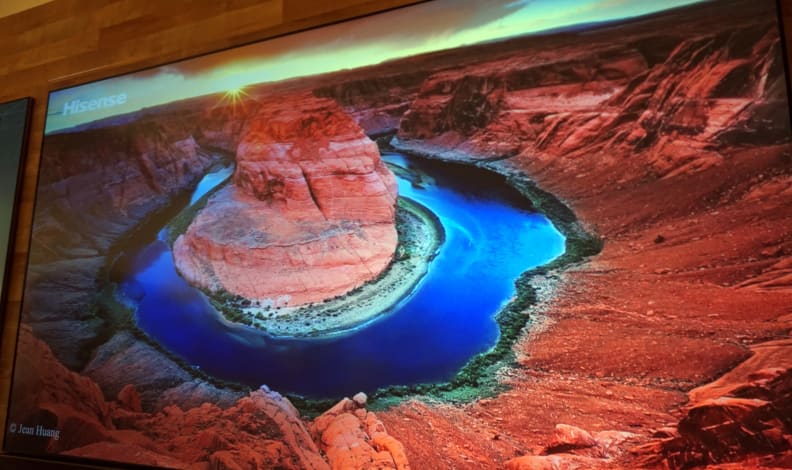
Representatives from Hisense claimed the Laser Cinema TV could produce as much as 85% of the NTSC color space, though the film playing looked like standard HD color to me—which could be a good thing.
The best thing about the Laser Cinema TV, though, is how large the image is considering how compact projector itself is. The whole device actually weighs less than most 60-inch TVs. It's a simpler solution than setting up a huge 100-inch display, and because it's a projected image, the viewing angle should be great in a light-controlled space.
The Verdict
Lasers: not just for cats anymore
The Hisense Vidaa Max Laser Cinema TV is the company's first nudge toward a flat-panel free future. The specifications here all check out, even if none of them are future-proofed for the coming tide of native 4K content. But Hisense did claim they'd be introducing a 4K short-throw projector by summer 2016, so the company is clearly poised to support its projector lineup.
The pros here are the massive image size and easy setup. The cons are the relatively low resolution of the screen and the inability to play or view 4K content, which is going to be readily available this year.
Hisense hasn't confirmed a price, but the Laser Cinema TV is selling for about $9,600 in China, and should be notably cheaper than that when it arrives stateside. It won't be "cheap," but will definitely undercut similarly sized LCD panels.
Is this the beginning of the end for flat-panel TV technology? We seriously doubt it, but the Laser Cinema short-throw projector looks like a good start nonetheless.
Meet the tester
Lee was Reviewed's point person for most television and home theater products from 2012 until early 2022. Lee received Level II certification in TV calibration from the Imaging Science Foundation in 2013. As Editor of the Home Theater vertical, Lee oversaw reviews of TVs, monitors, soundbars, and Bluetooth speakers. He also reviewed headphones, and has a background in music performance.
Checking our work.
Our team is here to help you buy the best stuff and love what you own. Our writers, editors, and experts obsess over the products we cover to make sure you're confident and satisfied. Have a different opinion about something we recommend? Email us and we'll compare notes.
Shoot us an email

